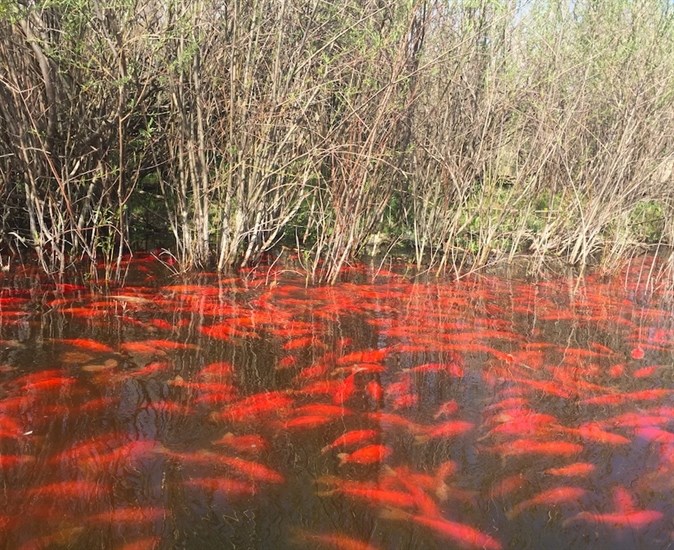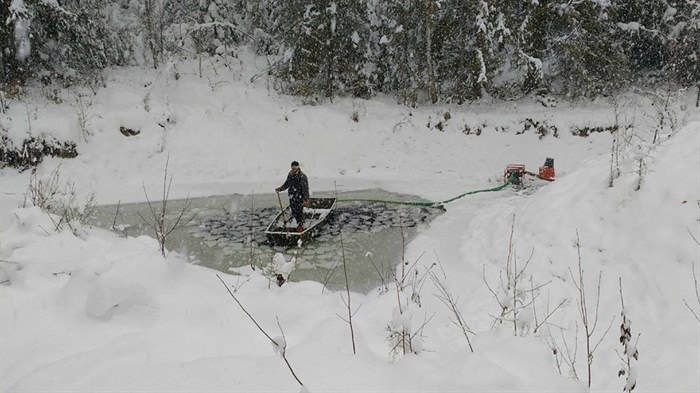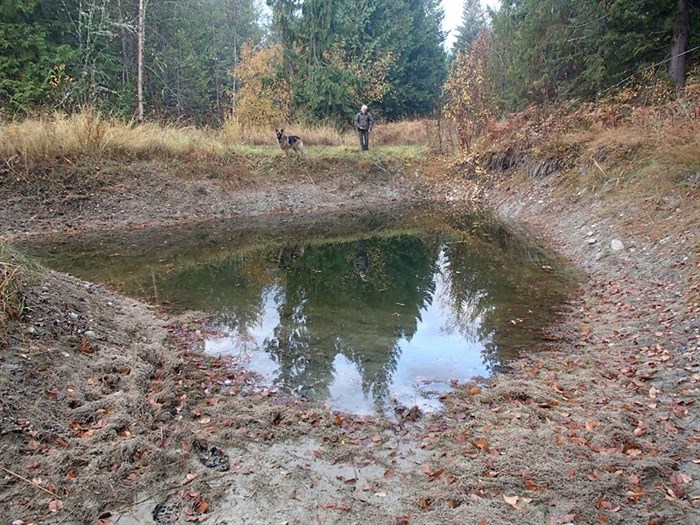
In this photo from 2016, a pond in the Okanagan region (not Ken Buck's) is seen teeming with goldfish.
Image Credit: Pete Wise
November 23, 2017 - 8:00 PM
NORTH OKANAGAN - Ken Buck made an unusual discovery during a walk around his new North Okanagan acreage last year: a pond, in the middle of the woods, filled with goldfish.
“It’s a head scratcher, that’s for sure,” Buck says.
From what he could see, there were about three-to-five large fish, measuring roughly six-to-eight inches, and “a whole whack” of smaller, two-inch ones.
“In the fall, we noted there were a lot of even smaller ones,” he says. “They’re obviously doing well down there.”
Wild goldfish, though you may not have heard of them before, are not exactly a new phenomenon in the Okanagan. Wildlife control expert Pete Wise hasn’t been involved with Buck’s goldfish, but he has received a small number of other calls over the past couple of years from people stumped by the presence of the bright orange fish in their ponds. He took the photo above and says it's a scary example of what things can look like if invasive goldfish populations go unchecked.
He believes goldfish were introduced into the wild by soft-hearted pet owners who didn’t want to kill them or flush them down the toilet. Goldfish of many different varieties are members of the carp family and native to eastern Asia. Once introduced to the wild here, he says the only thing that can be done is to “dispatch them.”
“You have to be coldhearted and merciless,” he says. “Once they get in a waterway — like any invasive — you have a whole bunch of difficulties.”
He usually drains the pond, scoops out the fish, and disposes of them.
Buck — thinking it better to be safe than sorry — contacted the Ministry of Environment about his pond.
“I started worrying that the little creatures or the eggs might escape,” he says. “That could be a pretty big disaster.”
He says the Ministry was grateful for his call and took quick action to help him develop a plan for getting rid of the goldfish.
One option was rotenone — a chemical that has been used in other lakes to kill invasive fish — but that requires a lot of approvals and is expensive, Buck says. Instead, a plan was devised to drain the pond and scoop out the fish. The operation was executed at the beginning of November with mixed results due to the early snowfall and cold snap, Buck says.

Biologist Jason Webster attempts to drain Ken Buck's goldfish pond in November 2017.
Image Credit: Contributed
“I was up there this morning and the fish are kinda looking at me sticking their thumbs up saying ‘haha,’” Buck says. “We’ve had temperatures in the minus for quite a long time and these guys have had hardly any water. They’re a little slow, but happily cruising around under the ice chunks.”
Jason Webster, a local biologist that was hired by the province to work on Buck’s goldfish pond, says the fish can survive extremely low oxygen levels and are generally quite hardy.
“They’re just crazy, you almost can’t kill them,” he says.
He applauds Buck for recognizing the potential environmental threat and taking action. While pretty and colourful, Webster says goldfish belong in aquariums, not the wild — something not everyone understands.
“More often than not, it’s do-gooders dumping their pet goldfish into a local creek or pond and thinking they’re doing good by not killing them,” he says.
Once released, he says goldfish can grow up to about 10 inches long with an ample food source.
“They eat whatever is around and it takes the food source away from the native species,” Webster says.
He says property owners that find goldfish on their land shouldn’t panic if the pond is fully self-contained, but they should make sure no water is trickling elsewhere.
“You don’t want to be responsible for goldfish getting into our waters,” he says.
As for Buck, he’s determined to rid the pond of the fish — even if they are rather ornamental.
“Beauty is in the eye of the beholder, I guess you could say. We were kind of intrigued in the beginning but, anything that doesn’t belong doesn’t belong. If they’re occupying a space that belongs to something else, that’s a problem. My objective is to stock the pond with native fish and create a proper ecosystem,” he says.
Invasive species reports can be made by phone or online.

North Okanagan resident Ken Buck is determined to rid this small pond of goldfish.
Image Credit: Contributed
To contact a reporter for this story, email Charlotte Helston or call 250-309-5230 or email the editor. You can also submit photos, videos or news tips to the newsroom and be entered to win a monthly prize draw.
We welcome your comments and opinions on our stories but play nice. We won't censor or delete comments unless they contain off-topic statements or links, unnecessary vulgarity, false facts, spam or obviously fake profiles. If you have any concerns about what you see in comments, email the editor in the link above.
News from © iNFOnews, 2017